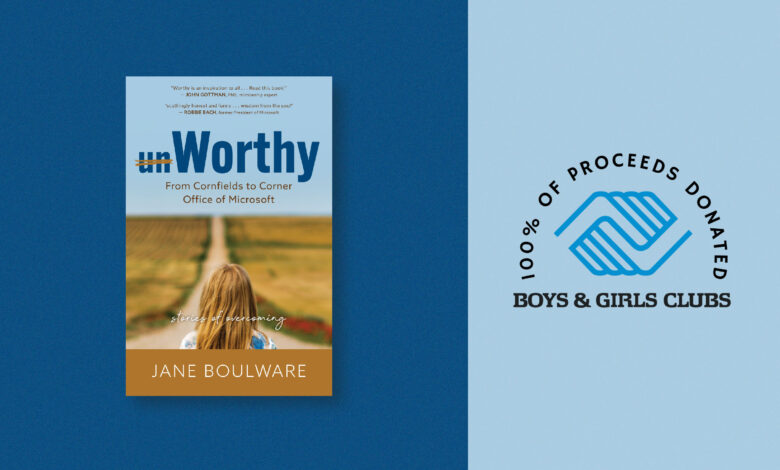
Correction of Errors- An excerpt from Worthy
[ad_1]
“Your life does not get better by chance; it gets better by change.” -Jim Rohn
On the outside, all was well. My family was flourishing and happy. The device team had gained momentum and recognition. Despite renewed physical mobility, my world became smaller as I spent more time in meetings and business reviews than with customers or partners, and more effort in defending than enabling the team. I couldn’t shake a growing sense of disquiet and discontent.
Microsoft was undergoing a cultural shift under the leadership of Kevin Turner, who had been hired by Steve Ballmer to tame Microsoft’s wild, wild west ways. Kevin Turner, known as KT, was a seasoned exec hired as Chief Operating Officer to create a culture of fiscal accountability. KT came to Microsoft like a sheriff slinging a big gun and a saddlebag full of business scorecards.
“You manage what you measure,” became a popular new saying within Microsoft. The device team was being measured within an inch of our lives. Too big to be treated as a startup that could fly undetected and under the radar, success had put us on the firing line. The scrutiny was understandable given how much the business had grown and how much visibility Wall Street was placing on Surface/Windows tablet sales vs Apple/iPad sales. A battle for the enterprise was underway. There was a lot at stake. But the team was still learning to fly, still building the wings and instrument panel as our plane soared, leaving lots of ways to interpret which direction and how high we were flying.
KT’s scorecards measured and assigned green, yellow or red to virtually every activity done by sales and marketing teams. Green was good. Red was not. Those whose sales or marketing targets had become red were quickly shot by the big guns. The professed goal was to create targets that were SMART (specific, measurable, attainable, relevant and time-bound). In reality, goals were set to achieve aggressive targets based more on Wall Street’s expectations than market realities.
Soon the culture became so scorecard centric and fear-based that managers would do almost anything to avoid missing their targets, even if it sometimes undermined the business and the people. Those who missed their numbers ‘went red’ and were dutifully flogged in a Correction of Errors (COE) business review until they were once again ‘in the green’ and out of the firing line. You could tell which teams were caught in a red Correction of Errors death spiral by their pale pallor and slumped shoulders. Once caught in the grip of a COE, it became a game of survival where people’s self-worth and career were on the line. Businesses stuck in the red were guilty until proven innocent and subjected to weekly inquisition, which only ended once you became green or were reassigned to a new job.
When people care more about avoiding failure than achieving success, they stop playing to win and begin playing not to lose. There is no winning a game played not to lose. Mistakes can be milestones from which you build and grow or crushing millstones under which you stumble and fall. Accountability creates confidence while flogging creates fear and casualties. I know, because even though my scorecard was usually green, I began to invest more and more energy in avoiding red and defending results rather than taking risks and celebrating successes.
My top tier sales team began toppling from the time spent logging, reporting and uploading data into a system created by Paul and analyzed by Jason who became so proficient at data slicing and dicing that he was reverently known as The Sword. Juliana took The Sword’s information and smooshed it into an Excel spreadsheet, which spit out a graph that was cut and pasted into PowerPoint slides I pored over prior to presenting from the front line.
Correction of Error business reviews occurred monthly if green and weekly if red, starting before 8am and ending past 6pm, with patience and humor waning as the minutes slowly passed. The too small conference room was filled with the smell of taco bar, Sterno and fear as two dozen executives responsible for managing billion-dollar businesses sat glassy eyed and numb, avoiding eye contact in case they got asked a precision question they didn’t know how to answer and would throw others under the bus to save themselves. Tensions mounted as chests constricted, anxiously dreading the clock’s advance toward the allotted time to plead your case and receive a verdict…a green stay of execution…or RED! Go to COE jail! Do not pass go, do not collect $200. Only this was not a game. Executives torn to shreds in those meetings often did the same to their teams the following day, until everyone felt like confetti… without the celebration.
Perhaps one of the more bizarre but well-intentioned gestures of support I received at Microsoft was being handed a tube of Preparation H just prior to entering a COE review. “It’ll reduce the bags and dark circles under your eyes… never show signs of weakness, Jane.” Uh…Thanks? It did indeed help the dark circles under my eyes but did not help me see the dark swirl and strain I carried home each day.
It was impossible to spend long days at work scrutinizing and wallowing in what wasn’t right, then magically switch gears once home. I know. I tried. My negativity formed a dark cloud that followed me over the threshold, raining toxic thoughts that drowned the good and made it difficult for positivity to get a foothold. Research shows the average person has up to 60,000 thoughts per day and roughly 80%-95% are negative (closer to 100% if in a COE), creating negativity bias.
People experiencing negativity bias:
- remember traumatic experiences better than positive ones
- think about negative things more frequently than positive
- recall insults better than praise
- react more strongly to negative stimuli
- respond more strongly to negative events than to equally positive ones
Check, Check, Check, Check, Check. Ugh.
Scott responded by amplifying the negativity I brought home, creating a nasty swirl that began spiraling out of control despite our best efforts. We became so raw that even the most innocent comment chaffed. Our marriage was going red; we needed a COE… without the firing line. I turned to Karla Obernesser, dear friend, marriage counselor and co-founder of WeDoRelationships. I respected and trusted Karla immensely but didn’t want to cross the line from friend to counselor. She told me about Drs John and Julie Gottman, renowned authorities on marriage and creators of the Gottman Method, the world’s leading approach to couples therapy. Karla suggested looking for a Gottman Certified Counselor. I looked for the Gottmans. I didn’t have far to look. Their practice was in Seattle.
Dr John Gottman is known for conducting 40+ years of research on marital stability. John Gottman can watch a 10-minute conversation between romantic partners and identify patterns of behavior that with 90% accuracy predict divorce in the next six years. So naturally, he wanted to meet with Scott and I before agreeing to counsel us. It was like sitting down beside a very wise, kind, kinda rumpled grandpa wearing a yarmulke in a room filled to the brim with books and papers. But this was no Hallmark movie and John was Dr Gottman, not my grandpa. As we talked, Dr Gottman discreetly assessed and mentally calculated the likely success of our marriage and whether he could help us.
Over the next months, John guided us through the Gottman Method. He exposed us to information and skills we hadn’t learned or experienced growing up, like how to overcome gridlock, turn toward vs away, make and receive bids for connection. He helped us recreate a shared sense of meaning. We learned having a 5:1 ratio of positive to negative language can predict successful relationships and that happy couples have a 20:1 ratio of positive to negative expressions when simply conversing. Drs John and Julie Gottman found the four behavioral predictors of divorce or break-up are criticism, defensiveness, contempt and stonewalling. They call these the Four Horsemen of the Apocalypse.
There was much to learn and unlearn. Change is hard, but Scott and I were motivated. We changed horses, became intentional about noting the positive in one another and learned to fight better because our relationship was worth fighting for. In truth, I have worked more and fought harder for my marriage than anything else in my life. Sometimes it felt our relationship hung by a thread. Not a golden thread, mind you, but a natty piece of twine, frayed and grey, at risk of snapping under the weight. When things got too heavy, friends and counseling lightened my spirit, rekindled my commitment, and helped me hang on until I could dispel the darkness of negativity and find my way back to seeing the positive in Scott, others and life. For me, marriage takes a community effort and requires constant care, maintenance and adjustment.
In the process of meeting and getting to know us, John encouraged me to put my thoughts and stories to paper, to write a book. He handed me the business card of his publisher (I think it was his publisher?), telling me to call him when I was ready. I taped that business card to the bottom corner of my PC, where my gaze tends to land. It represents hope, I guess. It’s been years since I first taped that card. Over time, the tape starts to curl a bit at the edges. Occasionally, I adhere new tape to the old, so there are now several layers securing that card. But the card stayed stuck. So did our marriage. Without John’s encouragement and counseling, I likely wouldn’t be married, and you likely wouldn’t be reading this book.
Whatever I focus on becomes bigger while everything else recedes. When I focus on errors, I find plenty. A focus on correcting the errors of others is a mistake that put my relationships in the red at home and at work. Conversely, there is a gob of research by the Gottmans, Mayo Clinic, Harvard, National Institute of Health etc on benefits of positivity and a positive mindset, including:
- better relationships
- improved productivity, creativity and engagement
- improved emotional and physical health
- reduced stress; happier and more confident
- attracting positivity and positive people (because it’s contagious and likeable!)
Check, Check, Check, Check, Check. Yay!
I couldn’t change the culture at Microsoft. Enduring the constant COE focus on what was wrong was exhausting. But resistance is not futile. My team and others made time to laugh, celebrate, support and reinforce the small things that make big differences. By doing small things often, my relationship with Scott and others went from red to green, from a correction of errors to a celebration of successes. In the process, my view changed, my perspective changed, my future changed. I changed. Because life does not get better by chance; it gets better by change.
Check.
[ad_2]





